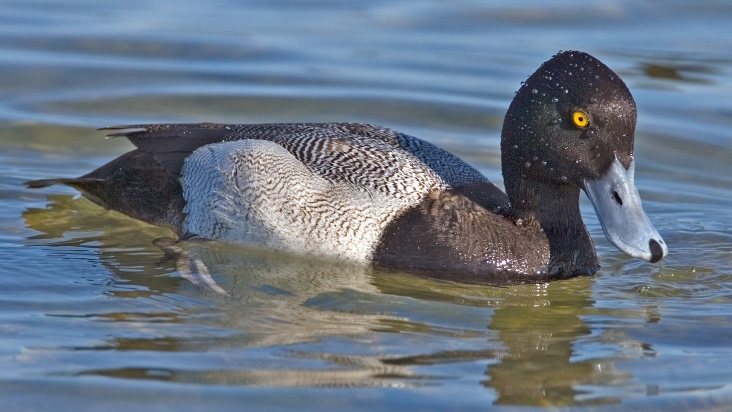Lesser Scaup
From Wikipedia, the free encyclopedia
[Photo] Aythya affinis - Lesser Scaup drake, Fulton Harbour, Fulton, Texas. Source NaturesPicsOnline http://www.naturespicsonline.com/ Date September 2006. Author Alan D. Wilson (note: this image has been cropped from author's work)
The Lesser Scaup (Aythya affinis) is a small diving duck.
Adults are 38-45 cm long, with a blue bill and yellow eyes. Adult males have a dark head with a purple sheen, a black breast, a light grey back, a black tail and white underparts. Adult females have a white band at the base of the bill and a brown head and body. They are smaller than the Greater Scaup, but may be an offshoot thereof, or they may both be descendants from a commmon ancestor.
Their breeding habitat is marsh ponds in Alaska and western Canada. They nest late in a sheltered location on the ground near water. Their chicks usually do not hatch until July, and they are one of the later types of waterfowl to migrate south.
There can be difficulty in distinguishing the Greater and Lesser Scaup. The differently colored sheen on the head is unreliable because light conditions vary, and these birds are often far from the shoreline.
The Lesser Scaup is best identified on its much smaller size, different head shape with a peaked hind crown, and a white wing bar that is visible only on the secondaries (it extends onto the primaries in Greater). The drake also shows vermiculations on the back. In North America, a large Scaup flock will often have both species present.
Lesser Scaup migrate in flocks and winter in lakes, rivers and sheltered coastal waters along the west coast of North America, the southern United States and northern South America. They are more likely to be found on freshwater than Greater Scaup. These birds move south late in the fall and return in early spring.
They are a rare but apparently increasing vagrant to western Europe, where the identification also needs to exclude similar looking hybrids. The first British record was a first-winter male at Chasewater, Staffordshire in 1987 (Evans 1987) but by 2006, over 60 had been recorded.
These birds dive and swim underwater, occasionally dabbling. They mainly eat mollusks and aquatic plants. It has been reported that both the Lesser and the Greater Scaup have shifted their traditional migration routes to take advantage of the presence of zebra mussels in Lake Erie. This may pose a risk to these birds because zebra mussels are efficient filter feeders and so accumulate environmental contaminants rapidly.
http://en.wikipedia.org/wiki/Lesser_Scaup
| The text in this page is based on the copyrighted Wikipedia article shown in above URL. It is used under the GNU Free Documentation License. You may redistribute it, verbatim or modified, providing that you comply with the terms of the GFDL. |
|

